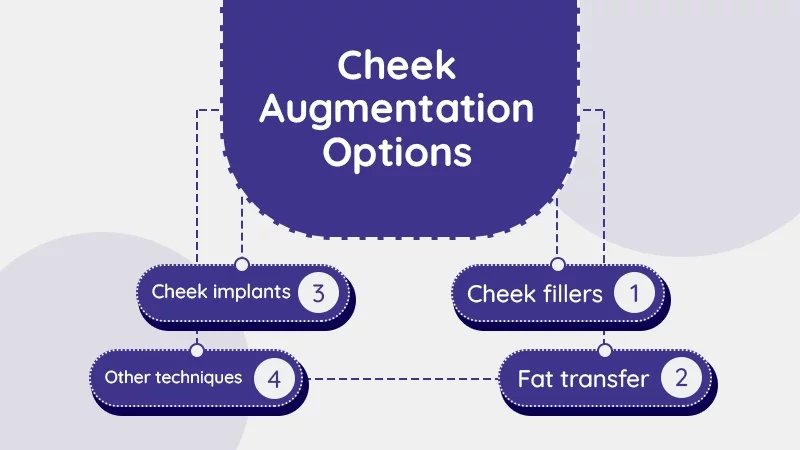
Published on 16 June 2024
Different Cheek Augmentation Techniques and How They Work
Fact checked
Cheeks play a crucial role in defining our facial structure, contributing to our overall appearance and symmetry. They provide contour, shape, and balance to the face, framing the eyes and accentuating the jawline. However, as we age, the natural fat pads in our cheeks may diminish, resulting in a loss of volume and firmness. This can lead to a sunken or hollow appearance, making us appear older or more tired than we feel.
Recognizing the significance of cheeks in facial harmony, many individuals seek cheek reshaping procedures to restore youthful fullness, enhance facial symmetry, and achieve a more balanced profile. Whether desiring subtle enhancements or dramatic transformations, people turn to cheek augmentation to address various concerns, such as flat or undefined cheeks, asymmetry, or simply to achieve the coveted high-cheekbone look.
By understanding the importance of cheeks and how they contribute to our facial aesthetics, individuals can make informed decisions about undergoing cheek augmentation procedures to achieve their desired look and enhance their overall appearance. Join us as we delve deeper into the world of cheek augmentation and uncover the transformative possibilities it offers.
What is cheek augmentation?
Cheek augmentation is a cosmetic procedure involving injectable fillers, implants, or fat transfer to enhance the appearance of the cheeks. The goal of the procedure is to add volume and definition to the cheeks. The process can be done in a doctor's office or clinic and typically takes 30 minutes to an hour to complete.
Who are good candidates for cheek augmentation?
Good candidates for cheek augmentation include people who have lost volume in their cheeks due to aging, those with naturally flat or undefined cheeks, and those who just want to have more prominent cheeks for cosmetic reasons. The procedure can be performed on both men and women and tailored to suit individual facial features.
Candidates must be in good overall health, with no medical conditions that might complicate the procedure.
Cheek augmentation techniques and how they are done

There are several types of cheek augmentation procedures, including:
Cheek fillers
Many products are available for adding volume to the mid-face area. These include collagen fillers, fillers that give volume like hyaluronic acid, and fillers that help your body grow new tissue like calcium hydroxyapatite and poly-L-lactic acid. The effects of the fillers are temporary, lasting between 6 to 18 months, and require maintenance.
Injectable fillers are typically done in a doctor's office or clinic. The procedure begins with applying a numbing cream or local anesthesia to minimize discomfort. The filler is then injected into the cheeks using a fine needle. The procedure normally takes 30 minutes to an hour to complete.
Also Read: cheek fillers
Fat transfer (fat grafting)
Fat transfer or fat grafting is a technique in which fat is removed from one part/area of the body, mostly from the stomach or thighs, and then injected into the cheeks. Fat grafting is an attractive cheek augmentation technique due to its customizability, biocompatibility, low cost, and abundance of fat in most people.
Fat grafting typically involves three stages: harvesting adipose tissue (fat) from the donor site, processing the fat to remove cellular debris, oil, and excess fluid, and reinjection of the purified fat in the cheeks. The injected fat is then sculpted to create a more youthful and defined appearance. It usually takes 2-3 hours to complete the procedure under local anesthesia.
Also Read: fat transfer
Cheek implants
Facial implants are widely used to enhance the contours of facial features, including the cheeks. The most common types of cheek implants are silicone, Medpor (high-density porous polyethylene), and Gore-Tex (expanded polytetrafluoroethylene). Cheek implants are permanent and can provide more long-lasting results.
Cheek implant surgery is usually done as an outpatient procedure under general anesthesia. The surgeon creates a pocket for the implant by making an incision inside the mouth or along the lower eyelid. Implants are inserted and positioned to enhance the cheek shape. A surgical tape or suture is used to close the incision.
Cheek implants come in three general shapes: malar, submalar, or combined. Malar implants are placed right on the cheekbones. This gives a higher contour to the face, with more projection on the cheekbones. Submalar implants, however, aren't placed on the cheekbones. Their purpose is to augment the midface. Combined implants, also known as malar/submalar combinations, are extended implants intended to augment both the midface and the cheekbones.
Also Read: cheek implants
Other techniques
A facelift surgery to remove extra skin can be done in addition to these treatments, often as part of a plan. Some non-surgical options, Facial exercises, makeup techniques, and fascial massages can help to enhance the cheek area and create the illusion of a more defined and youthful appearance.
A zygomatic osteotomy is a procedure that is not done routinely. It is done as a reconstructive surgery for birth defects or traumatic injuries. During the procedure, the cheekbone is cut and then moved to its new position. A material like hydroxylapatite keeps it in place afterward.
How to prepare for this procedure?

Preparing for a cheek augmentation procedure involves several steps, including:
- Consultation: A consultation with a board-certified plastic surgeon is the first step in preparing for cheek augmentation. The surgeon will evaluate your facial features, skin type, and overall health to determine whether the procedure is appropriate for you and what technique would best achieve your desired results.
- Medical evaluation: Before the procedure, you may undergo a medical evaluation to ensure that you are in good health and can undergo the procedure. This may include blood tests, an electrocardiogram (ECG), and other tests as deemed necessary by the surgeon.
- Discontinue certain medications: Certain medications, such as blood thinners, may need to be discontinued in the days leading up to the procedure. Be sure to inform your surgeon of all medications you are taking, including over-the-counter drugs and supplements.
- Arrange for transportation: The procedure is usually performed under local anesthesia, but in some cases, it may require general anesthesia. Depending on the method used, you may need to arrange for transport home after the procedure as it may not be safe to drive by yourself.
- Prepare your recovery area: Have a comfortable place with pillows to elevate your head and ice packs to reduce swelling.
- Follow pre-op instructions: Your surgeon may give you specific instructions to follow in the days leading up to the procedure, such as avoiding certain foods and drinks or not wearing makeup or lotions on the day of the surgery.
Be fully prepared for the procedure and follow the instructions provided by your surgeon to ensure the best possible outcome.
What is recovery like?
Recovery from cheek augmentation will vary depending on the procedure performed and your healing process.
- Injectable fillers: Recovery from injectable fillers is usually minimal, with patients able to return to normal activities immediately after the procedure. Some mild swelling, redness, and bruising may be present in the early days.
- Fat transfer: Recovery typically takes about a week, but it may take longer if the patient experiences significant swelling or bruising. The patient should avoid vigorous exercises and sleep with a raised head for a few days.
- Implants: Recovery from cheek implant surgery usually takes about a week. The patient may experience swelling and bruising for a few days after the procedure. Patients may be advised to avoid strenuous activities and to sleep with their heads elevated for a few days.
Recovery time varies; for some people, it may take longer to heal than others. It's essential to follow your surgeon's post-operative care instructions and keep all post-operative appointments to ensure the best possible outcome.
Also Read: How to Get Rid of Jowls Without Surgery?
What are the side effects of cheek augmentation?
There is the possibility of side effects from cheek augmentation, as with any medical procedure. Depending on the procedure, specific side effects may occur.
- An injection/incision site may swell, redden, or bruise after receiving injectable fillers and cheek implants. It usually subsides within a few days.
- Infections, bleeding, or allergic reactions are uncommon but can happen, especially with implants.
- All cheek augmentation procedures can potentially lead to asymmetry due to implant displacement/migration, uneven resorption, or shifting. Shifting can be caused by swelling, trauma, or even scarring.
- Temporary numbness is a common side effect of surgery, but an extended loss of sensation can occur with any surgical procedure, especially cosmetic plastic surgery.
- If implants need to be removed, their integration and ingrowth with the underlying tissue may make it difficult.
- Unnatural results could be an undesired side effect of implants.
It's important to keep in mind that these side effects are generally mild and temporary. However, if you experience any severe or prolonged side effects or have any concerns, it's important to contact your surgeon as soon as possible.
What is the cost?

The cost of cheek augmentation will vary depending on the type of procedure being performed, the location of the practice, and the surgeon's experience. Generally, the cost for cheek augmentation can range anywhere from a few hundred dollars for injectable fillers to several thousand dollars for surgical procedures.
- Injectable fillers: The cost can range from $500 to $2,000 per syringe, depending on the type of filler used and the location of the practice.
- Fat transfer: The cost can range from $4,000 to $8,000, depending on the practice's location and the surgeon's experience.
- Implants: The cost can range from $3,000 to $8,000 depending on the practice's location and the surgeon's experience.
The cost of the procedure may not include additional expenses such as the cost of anesthesia, operating room facilities, or post-operative care. It is always best to have a consultation with a surgeon, to have an accurate cost. Also, most insurance companies do not cover the cost of cosmetic surgery, so patients should be prepared to pay for the procedure out of pocket.
FAQs about different Cheek Augmentation
How long do the results of cheek augmentation last?
The duration of results will vary depending on the type of procedure performed. Injectable fillers typically last between 6 months and two years, while the results of cheek implant surgery are typically permanent. Fat transfer results may last for several years.
Is there any age limit for cheek augmentation?
While there is no specific age limit for cheek augmentation, it is generally recommended for adults with good overall health and realistic expectations for the procedure.
Can cheek augmentation be combined with other facial procedures?
Cheek augmentation can often be combined with other facial procedures, such as facelift, eyelid surgery, or nose surgery, to achieve a complete result.
How should I choose the right surgeon for cheek augmentation?
Choosing a board-certified surgeon with experience performing the specific type of cheek augmentation procedure you are interested in is important. You should also feel comfortable asking questions and discussing your expectations with the surgeon.




